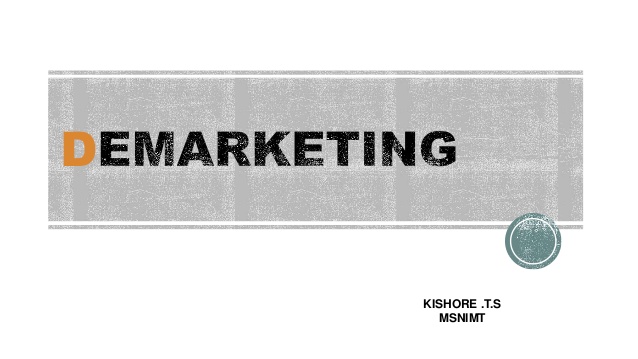Demarketing is simply defined as efforts made or steps taken by companies to reduce or discourage demand for a product generally. Demarketing ads can be done on the demand for a product in certain locations where the supply comes with much costs and little or no profits.
Why would a company want to run demarketing ads on a product or an arm of their business or service? How does this benefit a business? What are the reasons for demarketing? What are the types of demarketing? Do the advantages of demarketing outweigh the disadvantages? How can one develop an efficient demarketing strategy? These are questions we will answer in this article.
Reasons for demarketing
While demarketing meaning is perceived to be the use of advert to reduce demand. This is done by consciously running demarketing ads. The question that comes to mind is what could be the possible reasons for demarketing? Here are a few
#1. When Demand is more than supply
Too many demands and too little supply can birth new competitors into the market, so businesses try to demarket their products to curb this. One of the other reasons for demarketing in this regard is to reduce demand in a location, the company cannot supply or a market segment the business doesn’t want to sell to.
#2. Where you should conserve resources
There are businesses that depend on natural resources for their raw materials. Where these raw materials are not readily available or must be conserved, an example could be Trees and policies against deforestation, which might make a furniture company demarket their product to ensure demands match up with available resources.
#3. Poor or absent distribution chain
Of what need is a demand if you don’t have efficient means of getting the product to the market or customers? Businesses might try to demarket until they find an efficient seamless distribution channel.
#4. When the price of selling in a particular location is extremely high:
A business might choose to demarket its products in that location. When the cost incurred in selling makes the company go into losses or little gain compared to the stress and gain in other locations. Selling in such areas is usually considered not beneficial.
Read Also: 7 best brand marketing techniques
#5. Save consumers from health complications.
This is one of the major reasons for demarketing by the government and health agencies. They spend so much money to reduce the demand for alcoholic substances, cigarettes, and unhealthy drugs. This they do to help people maintain and live a healthy life.
There are many other reasons for demarketing, but the sole purpose of demarketing is to reduce demand and help a business make more profits from selling a few.
What are Demarketing Ads?
Demarketing ads are ads specifically targetted for the purpose of reducing demands for a product. An example of demarketing ads was coca-cola sponsoring ads warning people of dangers of consuming the coca-cola drink due to high sugar content simply because they want to raise the demand for their low sugar coca-cola drinks like diet coke. So they run demarketing ads against high sugar coke and then recommend the Diet Coke as a healthier alternative.
Read More: All you need to know about demarketing ads
Demarketing Examples
Putting a higher price on low-profit commodities just to encourage buyers to go for more quantity. Subscription packages can put a higher price on a 1month subscription package but lower prices when one subscribes for more than 12 months. The goal is to get loyal long-term customers by making people subscribe for a longer period. This might mean that the business earns more profit when people subscribe for a longer period. So, they try to demarket or discourage customers from short-term subscriptions.
Types of Demarketing
There are different types of demarketing every business should understand. Understanding these types of demarketing would help a business ascertain which one is best suited for the objective. It also helps you decide the strategy that needs to be executed. Here are the types of marketing to consider adopting.
#1. Selective demarketing:
This is simply choosing a certain type of people to market to. It means focusing on certain customer segments alone and leaving behind others to ensure they never buy. An example of this is seen in real estate businesses where a realtor only desires a certain kind of people to own property in a certain region and probably for a certain purpose.
One might choose to selectively market to individuals who want to build a production factory as they are more likely to buy more plots. They simply believe it would yield more profit selling to them.
Another example
could mean selling land to rich individuals simply because the realtor wants only rich people in that region. This could be for easy maintenance. It can also be for the simple reason that these sets of people are not price-sensitive. They would be willing to pay more than the poor.
If Coca-Cola notices that they earn more profit from selling Fanta drink than they do selling Coke, they may let out much propaganda to make people discover how coke can be poisonous to their health and that Fanta is the better alternative. Every demarketing agenda is targeted toward making more profits while reducing costs and losses.
#2. Ostensible Demarketing
This is done by making people believe a certain product might soon be scarce in the market. This can be achieved by also making people believe that if they don’t buy a certain product at a particular time, they might never buy it again at all or at such a lower price. What effect does this create?
People would want to rush the product before it gets scarce. So, this will enable the company to increase the price and gain more profits.
This was experienced shortly before the COVID-19 lockdown of 2020 when people believed that if they don’t buy foodstuffs now, they might never be able to buy again. Many bought so much that could sustain them through the indefinite lockdown so they could store up.
This also happens during seasonal periods like Christmas when products are hoarded and reserved to be sold in Christmas periods so more profits could be made.
Read Also: How to create seasonless marketing strategies
The strategy behind this is to create scarcity so demand can increase as this would cause price increase and thus more profit.
This happens occasionally in the forex and exchange market where people hoard a certain currency believing scarcity of it would increase demand. BMW did this too in 1997 by restricting its supplies in the UK market. So a lot of people sought to buy this “hard to find” commodity.
#3. General Demarketing.
General demarketing is seen when a company or government really wants to reduce the demand for this product not for some people but for everyone. An example is a government demarketing the sales and production of alcoholic substances and cigarettes for everyone and everywhere.
Best Demarketing strategies
There are many demarketing strategies one can execute in business to maximize profits
#1. Differentiation Strategy
This demarketing ads strategy hinges on the 4Ps of marketing to implement demarketing efforts. It lays emphasis on place, product, price, and promotion.
A business might increase the price of their product in other to wade off price-conscious individuals from buying. Most businesses believe that price-conscious individuals give the most complaints and concern over seemingly little issues. To successfully do this, you need to learn how to raise the price without losing your customers to your competitor
Read Also: 15 ways to retain your valued customers
The idea of place is to make a purchase in a certain location very difficult either by reducing supplies in that location or increasing the price. it can also be done by consciously running demarketing ads in such locations. This might be because it costs the business more to supply to those locations thereby incurring losses or low gains.
On the product aspect, a business might remove a warranty on a product so as to discourage people from buying it. On the contrary, When a business launches a core product, it might increase the warranty on the new product. This would make people run after the new product even when it has fewer features.
Thinking of promotions, a business might just stop all promotional activities targeted on selling a product. They simply stop the advertising, remove the added value on the product, etc
#2. Bait and switch strategy
This can be illegal and one can get sued for this as it thrives on deception. This type of demarketing ad is advertising an extremely great product at an extremely low price. It’s also called a “too good to be true” price when actually the product isn’t available.
When people troop in to purchase, they are told the product is unavailable, convincing them to buy another product. It’s a “bait” to catch people’s attention and then “switch” them to another product at a higher price.
One major characteristic of this strategy is that it thrives on a “too good to be true” price and also on deception. Before applying this, learn these 12 ways to give excellent customer experience
#3. Price discrimination strategy
To achieve this, businesses input cost transactions on product payments. This can be just a flat rate transaction cost irrespective of whether one is buying 1 product or 100 products. It discourages people from buying just 1 and gears them towards buying as many as possible in other to spread the cost and maximize gain.
#4. Stock Outage strategy.
This is to create an artificial shortage of products, this will make people pay in advance. This might help a business use the money paid as advance payment to finance the production.
#5. Crowding cost demarketing
When there is a discount or promo on special days like Black Friday sales, there could be queues which make purchases difficult. This would make a few customers willing to pay higher just to evade the queue.
Advantages of Demarketing
The following advantages of Demarketing explain why a business would demarket its products.
#1. To reduce cost and increase profit:
when a business feels like they don’t gain anymore from a product, they try to demarket it and channel people’s attention to products that have the likelihood hood to earn them more.
#2. To conserve resources:
when production material is scarce companies tend to demarket the products so as to reduce demand and give room for the production materials to replenish. This is seen when these materials are natural resources like trees etc, used for furniture and books.
#3. Health benefits:
This advantage of demarketing is seen in the government’s effort to reduce the demand for tobacco, alcoholic drinks, herbal drugs, etc.
#4. Turn off wrong customers:
It helps businesses turn off the wrong customers to focus on a more lucrative customer/market segment. A hotel that wants to set a standard of prestige might put a high cost so as to keep low-income earners away.
How to develop a Demarketing strategy
- Understand consumer behavior well enough to ascertain which strategy to imbibe.
- Understand the marketing goals and objectives of your firm and choose the demarketing strategy that helps you achieve these goals.
- Combine these 2 above to craft a good strategy.
Marketing is not always a good option. I have also written on how marketing can kill your business. It will give you an insight into when not to market and employ demarketing ads effectively. I hope you learned from this article. Tell me about it in the comment session below, and also drop your questions. I will be glad to give replies to your comments.
Demarketing FAQs
What is demarketing and green marketing?
Green Demarketing is “a strategy in which a brand encourages consumers to buy less in a category by buying the company’s brand in order to help the environment.” One example of this kind of communication is the 2011 “Don’t Buy This Jacket” campaign from Patagonia.
Why is demarketing important?
Demarketing is an important tool that is used to limit demand or consumption of a certain product or service, or to make better use of it, either permanently or temporarily (fuel, electricity, water, etc.). This is done because these resources are rare and important to a country’s economy.
What is demarketing in banking?
In banking, a demarketing letter is a notice from the lender to the borrower that the lender plans to close some or all of the borrower’s accounts. The letter could also say that there is less or no credit available on revolving facilities.







